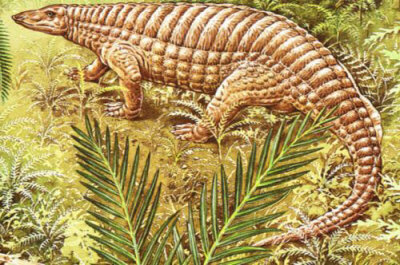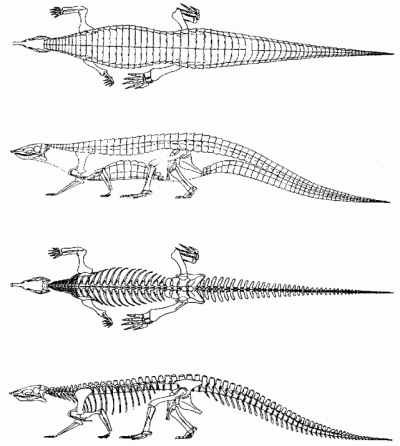(names of taxa in "inverted commas" are suggested here and have not been formally recognized)
These reptiles were exceedingly well armoured, even by archosaur standards. Their bodies protected by bony plates, including large, interlocking plates over the back, and sometimes spikes as well. All were quadrupedal, walking on four legs and probably relying on armour and (often) large size rather than speed to protect them from their enemies.
The small heads and weak, leaf-shaped chisel-like teeth indicate a herbivorous lifestyle. The teeth are leaf-shaped and chisel-like, very much of the sort that other plant eating reptiles have, indicating that they probably nipped off leaves and digesting them in their gut with the aid of symbiotic bacteria. Advanced forms Typothorax etc) especially had bulky bodies, indicating fermentation of plant material. However, it has recently been suggested [Small 2002 ] that an edentate-like lifestyle of feeding on insects may also be possible
Unlike the phytosaurs and basal archosauriformes, but as with other advanced archosaurs, for example dinosaurs and sphenosuchid crocodylomorphs, aetosaurs had a fully erect posture, with the hind limb held beneath the body. Aetosaurs are united with prestosuchids and rauisuchians in the horizontal orientation of their acetabulum. This seems to have been an adaptation for an erect posture, but it is not agreed whether or not it is a synapomorphy (shared common ancestral feature) or something that evolved a number of times among different reptilian lineages.
In overall lifestyle, the aetosaurs must have paralleled other herbivorous tetrapod "tanks": pareiasaurs of the Permian, or the armoured scelidosaur, nodosaur, and ankylosaur dinosaurs that were to appear and diversify in the succeeding Jurassic and Cretaceous periods; and even the armadillos and the giant glyptodontid edentate mammals of the South American Cenozoic era. As is often the case with evolution, we see an example of a particular form, evolving and flourishing for millions of years, then eventually dying out, to be replaced tens of millions of years later by another, unrelated line, which independently evolves the same basic form, and again flourishes before it too dies out, to be replaced again later by yet another evolutionary line.
Aetosaur scutes (bony armour plates) can be readily distinguished from scutes of other armoured Archosauria. They are characterized by a flat, rectangular shape, presence of an anterior articulating surface, and lack of anteriorly- or posteriorly- projecting lappets (Heckert et al, 1999). Different aetosaur genera have differently shaped scutes, and this can be used as a diagnostic feature (Heckert & Lucas 1999)
Aetosaur systematics is still controversial; a serious problem is the frequent lack of adequate material [Heckert & Lucas 2003]. There is even a disagreement over whether a certain species is a synonym of another species or a whole different genus! The following systematic arrangement therefore is extremely speculative and armchairish, and should not in any way be taken as a formal statement on aetosaur phylogenetics! MAK 000608 and 030803).
Rauisuchiformes: Rauisuchia + * : Aetosauridae + (Euscolosuchus + (Gracilisuchus + (Erpetosuchus + Crocodylomorpha))).
quadratojugal contacts postorbital [$P93]; ventral ramus of squamosal short or absent, with triangular lower temporal fenestra [$S91] [3]; foramina for cerebral branch of internal carotid on lateral surface of basisphenoid [$G02] [1]; occipital margin of parietals straight in dorsal view [π$03]; exoccipital with clear lateral vertical crest anterior to hypoglossal foramen [π$03]; exoccipitals extend further laterally than ventral ramus of opisthotic [π$03]; ventromedial surfaces of exoccipitals do not meet on floor of cranial cavity [π$03]; elongate region between fenestra ovalis and posterior of occipital condyle [π$03]; perilymphatic foramen with completely ossified border [π$03]; perilymphatic foramen transmits perilymphatic duct out of otic capsule more laterally than posteriorly [π$03]; foramina for trigeminal nerve & middle cerebral vein at least partially separated by prootic [π$03]; tibial facet of astragalus with a prominent posteromedial excavation that forms a posteriorly directed concavity" [$P93] [π$03] [2]; osteoderms sculputred [π$03].
Notes: [1] synapomorphy of clade uniting Prestosuchidae with Suchia [G02]. [2] "[π03]" refers to our own analysis of published data. [3] Sereno posits this as a synapomorphy of a broader "Suchia" equivalent to our Rauisuchiformes less Onithosuchidae. As to this taxon, he is wrong, since the prestosuchids plainly have an extended ventral ramus of the squamosal. He may be correct that the rauisuchids and poposaurs do not. However, this appears to be more similar to the condition in Doswellia in which fenestration is reduced generally, the skull is flat, and the squamosal ventral process is absorbed into a broad, laterally-facing squamosal lamina. The state in Suchia is rather different: the temporal fenestrae remain large, and the squamosal simply lacks any significant ventral development.
Links: Lecture 10 - Triassic: Newark, Chinle.
References: Gower 2002 [G02], Parrish (1993) [P93], Sereno 1991) [S91]. ATW040117.
Aetosauridae: = Stagonolepididae, Aetosauria): Armoured Suchia.
Small head; premaxilla upturned, anteriorly flattened [$P93]; premaxilla without teeth anteriorly [$P93]; descending process of prefrontal absent [π$03]; lower temporal fenestra reduced & triangular [π$03]; braincase similar to rauisuchian/crocodylomorph condition [GW02]; exoccipital with lateral crest lying anterior to hypoglossal foramen [$G02]; leaf-shaped teeth; teeth small & nearly conical [$P93]; herbivorous; limb bones very stout, with hypertrophied trochanters (deltopectoral crest, 4th trochanter, intercondylar ridge of tibia & iliofibularis trochanter) [$P93]; manus IV with <4 phalanges [π$03]; pelvis generally primitive, but great ventral extension of pubis; pubis length <3x acetabulum width (reversal) [π$03]; acetabulum open ventrally [π$03]; femoral 4th trochanter absent [π$03] [2]; tibia distally expanded, with rectangular distal end [π$03]; crocodyloid tarsus with large calcaneal tuber; heavily armored; complete carapace with lateral & ventral armor [$P93]; scutes flat, rectangular, with anterior articulating surface, but anteriorly- or posteriorly- projecting lappets absent [H+99]; two pairs of paramedian dorsal osteoderms, with more dorsal series often bearing spines [S92]; paramedian scutes wider than long, sculptured, & without lappets [$P93]; dorsal osteoderms with ornament typivally radiating from a boss near posterior margin [S92];
Notes: [1] "[π03]" refers to our own analysis of published data. [2] This directly contradicts [P93], as noted. The data used in our analysis for this character were taken from [B99].
Links: Introduction to the Aetosauria UCMP: Best on the Web); Aetosaur Introduction / Translation and Pronunciation Guide.
References: Benton (1999) [B99], Gower (2002) [G02], Gower & Walker 2002 [GW02], Heckert et al, 1999 [H+99], Parrish (1993) [P93], Sues 1992) [S92]. MAK030803, ATW031220.
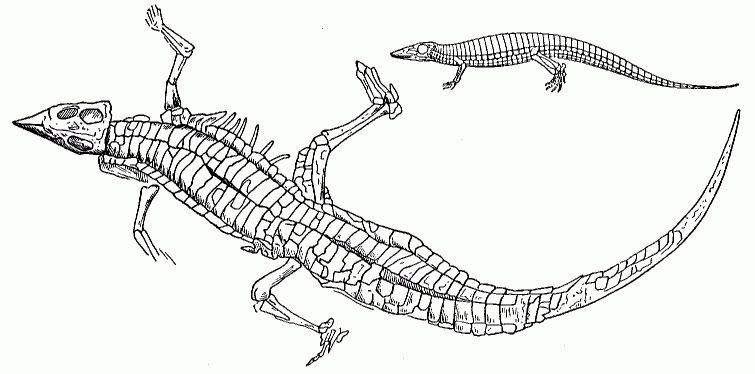
|
| Aetosaurus ferratus, a small and very primitive aetosaur, showing the complete animal as preserved, and a reconstruction of skeleton and armor. Length 80 cm. Norian of central Pangea (Laurasia - today, Stubensandstein of Germany). Composite of two individuals figured by O. Fraas; small image restoration after Marsh. Note - the animal in life had a more erect posture than shown here. Image from Gregory 1951 |
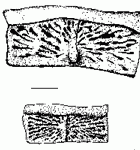
|
Aetosaurus dorsal view of paramedian plates, scale bar 1 cm
from Lucas 1998. |
Aetosaurus: = Aetosaurinae):
Aetosaurus O. Fraas, 1887
Late Triassic Early to Mid Norian) of North America, Greenland, & Europe. (also, scutes known from Madagascar)
Characters: Small (up to 1.5 meters); skull relatively large, triangular, acuminate in front. Orbit large; antorbital fenestra fairly large, separated from the nares by narrow ascending process of the maxilla. 25 presacral vertebrae; back completely covered with short and broad bony plates; dorsal and ventral armor of radially ornamented scutes, ventral scutes smaller than dorsal ones, almost square in shape. [Zittel, 1932]
Comments: A widespread early-middle Norian index fossil [Lucas 1998], known from Eastern USA (Newark Supergroup) the German Middle Keuper, Italy and Greenland. According to Harris et al 2003, Aetosaurus is the sister taxon of all known aetosaurs
Links: Aetosaurus sketch.
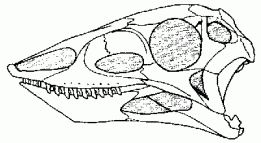
|
Aetosaurus ferratus, skull. Stubensandstein (Norian) of Germany
illustration in Krebs 1976, p.79. |
Aetosaurus ferratus: Western Aetosaurus -
Aetosaurus ferratus O. Fraas, 1887
Characters: small (85 cm [Zittel, 1932] or 1.5 meters ); scute with high W:L (Width to Length) ratio.
Comments: Based on a slab of two dozen complete but slightly crushed individuals from the Stubensandstein, Middle Keuper, near Stuttgart [Zittel, 1932].
Links: . Aetosaurus ferratus - University of Milan Vert Paleo page
Aetosaurus crassicauda: Western Aetosaurus - Aetosaurus crassicauda O. Fraas, 1887
Characters: small (1.5 meters in length); scutes with dorsal boss extending anteriorly past the middle of the scute as a longitudinal keel
Comments: from the Middle Keuper of Pfaffenhofen [Zittel, 1932]
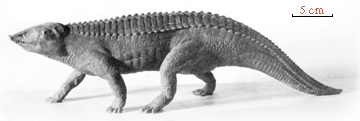
|
| Aetosaurus arcuatus, model of animal. Newark Supergroup (Norian - equatorial Pangea). From Professor Paul Eric Olsen Lecture 11 - Triassic: Newark, Chinle; photo by Donald Baird of Rush Studio model. |
Aetosaurus arcuatus: Eastern Aetosaurus -
Aetosaurus arcuatus (=
Stegomus arcuatus - [
Heckert & Lucas, 1999])
Characters: scutes more weaker sculpted [Creisler, 1996]
Comments: formerly known as Stegomus, and found in various localities of early or mid Norian age in the Newark Supergroup, this animal is now included in the genus Aetosaurus [Lucas 1998, Heckert & Lucas, 1999].
Characters: aetosaurs more derived than Aetosaurus - ref Parrish, 1994, Harris et al 2003
Comments: Includes all higher aetosaurs, the majority of the family. There are two family names for the Aetosauridae Nicholson & Lydekker, 1889, Aetosauridae (ex Aethosauridae) Baur, 1887 and Stagonolepididae Agassiz, 1844 (see Re: quick dino-related question) Usually these families are considered synonymous, so that only the family Stagonolepididae is used. However, if Aetosaurus is given its own family ranking as Aetosauridae, then the clade Stagonolepia would correspond to the Stagonolepididae sensu stricto
Comments: the less specialized of the higher aetosaurid clades. Although widely distributed, the stagonolepines did not survive the end of the Carnian. Corresponds to the "Stagonolepidini" of "Mikko's Phylogeny" [Aetosauria]
Characters: small (less than 1 meter); "dorsal paramedian plates considerably (3.25:1) wider than long, unflexed, lack keels or horns, and bear faint sub-parallel to radial ornamentation, and lateral scutes that are also unflexed, fiat, and bear a faint radial pattern of pits and grooves" [Heckert & Lucas, 1999], although scute lacks strong pitting [Heckert et al 1999]
Comments: I'm following "Mikko's Phylogeny" [Aetosauria] in including this form in the tribe "Stagonolepidini".
Reference: Heckert & Lucas, 1999
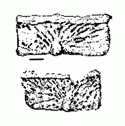
|
Stagonolepis paramedian plates, scale bar 3 cm
from Lucas 1998. |
Stagonolepis: Stagonolepis Agassiz, 1844
Characters: Large (length 2.5 to 2.7 metres); body is long and narrow; vertebrae with extensive transverse processes Long & Murry, 1995); scutes either radial (ray-like) ornamentation - although this may be indistinct in some parts of the body [Murry 1986 p.123] - of the shallow drop-shaped pits on the dorsal surface; dorsal paramedian scutes lack ventral keel, scutes wide and thin (have low width:length (W:L) ratio), anterior bar present, [Heckert et al 1999]; caudal paramedian scutes gently arched transversely Long & Ballew, 1985), dorsal boss quite pronounced and contacts the dorsal margin of the scute Long & Ballew, 1985: figs. 13-14; Long and Murry, 1995: figs. 69-72).
Comments: The aetosaur Stagonolepis was a prominent and widespread animal of the latest Carnian. It is distinguished from the contemporary desmatosuchines by somewhat smaller size, armour lack of spines, and ornamentation of dermal armor. Depending on one's choice of systematics, two or three species, included in one or two genera, are known, one from south-west Pangea (Argentina), one from north-central Pangea (Scotland), and one from the north and west equatorial Pangea (Arizona and New Mexico), although the ranges may have overlapped [Lucas 1998 p.368], and so possibly these may all only be subspecies or variations of the same cosmopolitan form. This is the first unnamed clade described in Parrish, 1994 (includes "Aetosauroides" and Stagonolepis.). Likewise according to Harris et al 2003, "Aetosauroides" is the sister taxon to Stagonolepis robertsoni
Links: .Stagonolepis; Stagonolepis (short description); Dinosaurios, tutorial interactivo - Stagonolepis; Dinowelt-Stagonolepis
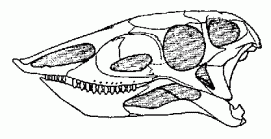
|
Stagonolepis robertsoni, skull.
illustration in Krebs 1976, p.79. |
Stagonolepis robertsoni: Western Stagonolepis -
Stagonolepis robertsoni (Agassiz, 1844)
Comments: The type specimen (consisting of dermal scutes) was originally mistaken for the scale of a large ganoid fish, but in 1859 Thomas Huxley correctly identified it as reptilian. [Creisler, 1996]. Fragmentary skeletons of about 20 individuals are known from the Lossiemouth Beds, Elgin, Scotland. In life the animal was a bit under 3 meters in length. Scroll up for skeleton and armor
Stagonolepis wellesi: Eastern Stagonolepis - Stagonolepis wellesi (Long & Bellew, 1985) Murray & Long, 1989 [= Calyptosuschus wellesi Long & Bellew, 1985)
Characters:
Comments: Known from the Lower Blue Mesa member, Petrified Forest Formation, Arizona and New Mexico, this species is extremely similar to Stagonolepis robertsoni, and hence serves as a useful index fossil [Lucas 1998 Heckert & Lucas 2002]. According to Aetosauroides scagliai is a synonym. If so, the unusual shape of the type skull of the latter is due to post-mortem distortion. This species was formerly considered to be a separate genus, Calyptosuschus Long & Bellew, 1985
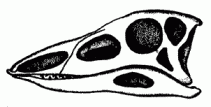
|
Stagonolepis scagliai / Aetosauroides skull (part of the type specimen)
illustration in Bonaparte 1971, p.671. |
Stagonolepis scagliai: -
Stagonolepis scagliai (Casamiquela, 1960); (=
Aetosauroides scagliai Casamiquela, 1960]
